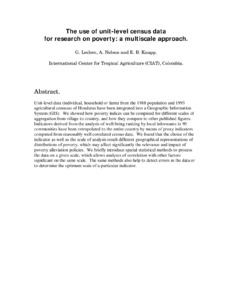The use of unit-level census data for research on poverty: a multiscale approach
Unit-level data (individual, household or farm) from the 1988 population and 1993 agricultural censuses of Honduras have been integrated into a Geographic Information System (GIS). We showed how poverty indices can be computed for different scales of aggregation from village to country, and how they compare to other published figures. Indicators derived from the analysis of well-being ranking by local informants in 90 communities have been extrapolated to the entire country by means of proxy indicators computed from reasonably well correlated census data. We found that the choice of the indicator as well as the scale of analysis result different geographical representations of distributions of poverty, which may affect significantly the relevance and impact of poverty alleviation policies. We briefly introduce spatial statistical methods to process the data on a given scale, which allows analyses of correlation with other factors significant on the same scale. The same methods also help to detect errors in the data or to determine the optimum scale of a particular indicator.

